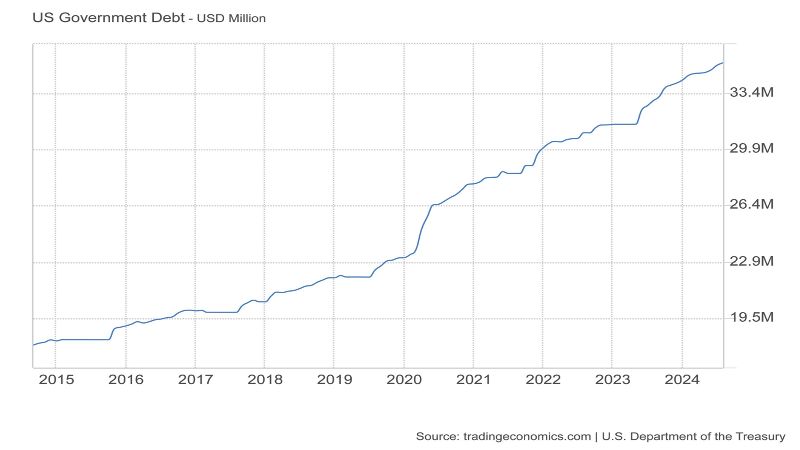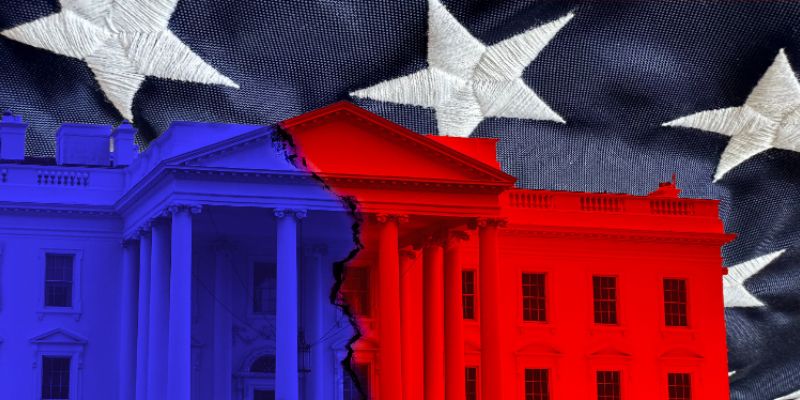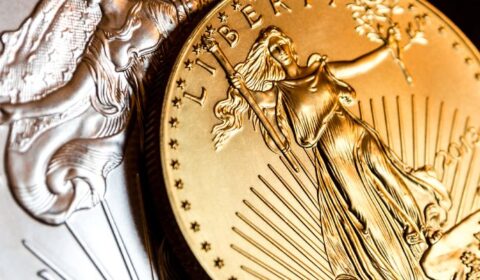US Debt: The Elephant in the Room that the Next President Cannot Ignore

It’s no secret that America has a massive debt problem. Just halfway into the year, our national debt surpassed $35 trillion for the first time in history. That’s equal to the GDP of China, Japan, Germany, India, and the United Kingdom combined.
U.S. debt is not only accruing at a staggering pace, it carries a hefty price tag due to the current high-rate environment.
“The U.S. Department of the Treasury has been required to issue increasing amounts of debt to fund government operations. The recent upturn in interest rates means the cost of financing government debt is more expensive. According to the U.S. Treasury, the average interest rate for all federal government-issued interest-bearing debt has jumped in recent years, to 3.28% as of June 30, 2024. The average interest rate paid today is more than double what it was in 2020.”

As of August 2024, it costs $1049 billion just to maintain our debt, which is 17% of our total federal spending budget for fiscal year 2024.
The sheer size of America’s debt is also now 123.8% of GDP, eclipsing our entire economic output. This is far worse than the debt-to-GDP ratio of most other countries including several of our rivals: China (24%), Russia (14.6%), Iran (7.5%), the European Union (81.7%), Canada (69.6%), Germany (62.4%), Mexico (48.2%), India (58.9%), and even Ukraine (79.4%).
America’s massive debt has a host of negative consequences in terms of future economic growth, business investment, crisis response, and the strength of the U.S. dollar. Fiscal think tank, the Peter G. Petersen Foundation, outlines the following concerns:
- Key investments in our future are at a risk.
Higher interest costs could crowd out important public investments that can fuel economic growth — priority areas like education, R&D, and infrastructure. A nation saddled with debt will have less to invest in its own future. - Rising debt means fewer economic opportunities for Americans.
Rising debt reduces business investment and slows economic growth. It also increases expectations of higher rates of inflation and erosion of confidence in the U.S. dollar. - Less flexibility to respond to crises.
On its current path, the United States is at greater risk of a fiscal crisis, and high amounts of debt could leave policymakers with much less flexibility to deal with unexpected events. If the country faces another major recession like that of 2007–2009, it will be more difficult to recover. - Essential safety nets at risk.
The unsustainable fiscal path threatens the safety net and the most vulnerable in American society. If the government does not have sufficient resources, essential programs like Medicaid and Social Security could be put in jeopardy.
As the 2024 Presidential election approaches, it appears that neither candidate has a serious plan for addressing America’s runaway debt or ongoing deficits as highlighted by CNN:
“As the dangers of a widening deficit and mounting debt grow, former President Donald Trump and Vice President Kamala Harris are making little effort to address it. Quite the opposite: Both their economic policy agendas, if enacted, would add to the ever-growing deficit.”
Chronic over-spending, bloated stimulus plans, billions in foreign aid, costly social programs, and unprecedented government borrowing — have all pushed America’s debt-to-GDP ratio to the highest level since World War II and made us one of the most indebted developed countries.

Regardless of the outcome of the 2024 election, it does not seem likely that our national disregard for fiscal responsibility will change, and this is driving gold prices to record highs.
“Escalating concerns over ballooning global debt and uncontrollable government borrowing, which currently sits at record $315 trillion … is yet another major catalyst fueling a global rush for gold – making allocation for precious metals in a diversified portfolio an essential necessity.”
And according to JP Morgan Wealth Management, the danger to the economy and the exposure to investors justifies an asset realignment and a new diversification strategy.
“The risks are meaningful enough to consider adding non-U.S. dollar denominated assets and ‘real assets’ such as infrastructure, gold, and commodities to traditional multi-asset portfolios. A focus on tax efficiency for U.S. taxpayers could also be prudent.”
So, while both candidates may “kick the can” on America’s exploding debt and govern via widening deficits and continuing resolutions, the debt elephant is the room is massive and immovable. And, the longer it’s ignored, the greater the odds of a catastrophic economic event like a market meltdown, recession, depression, or complete government default.
Gold has proven to be the most viable and reliable safe haven in a fragile and volatile debt economy.
This article was brought to you by Orion Metal Exchange, a top-rated precious metals dealer with “live” product pricing, full price transparency and best-in-class customer service. A precious metals expert is standing by at: 1-800-559-0088






